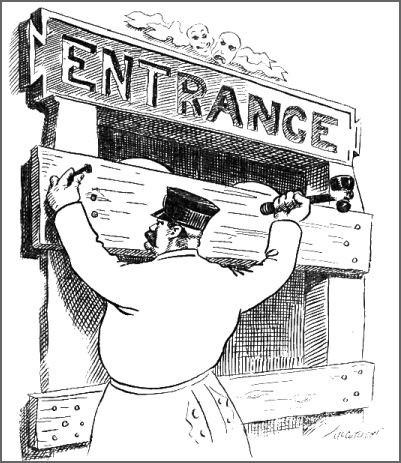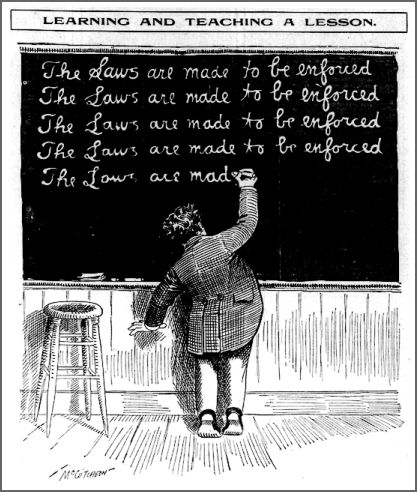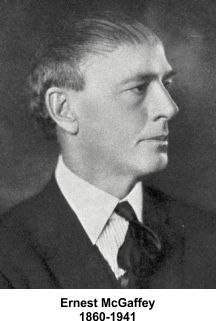|
Day 1 — December 31, 1903
One of his first meetings was with a committee of
Chicago aldermen who had just completed a tour of
the Iroquois Theater, followed by a visit to the
city building department where they had spoken with
deputy building inspector
Louis Stanhope. The
Aldermen were
Ernst Herrmann,
Winfield Dunn,
John Jones,
Henry Eidmann,
Luther Friestedt,
Peter Wendling and
John Minwegen. Their remarks to reporters
while at the Iroquois were probably intended to
express their constituents' feelings, but reports of their
response reminded me of a flock of
angry geese.
Not intimidated by their honking and flapping, Harrison
informed the delegation
that the city
council was as much to blame as anyone else in
the Iroquois disaster, pointing out, "Gentlemen,
on Nov. 2 of this year I transmitted to the city
council a report on the condition of the theaters of
Chicago, calling the attention of the council to the
failure of all the theaters to comply fully with the
terms of the ordinances. The report was prepared by
the commissioner of building. [George Williams]. The
council sent the communication to the committee on
judiciary for consideration, and pending a report
from that committee directed the commissioner of
buildings to suspend enforcement of the ordinances."
Harrison added that according to his recollection,
the judiciary committee then sent the report to a
subcommittee that went to sleep.
Alderman Herrmann defended the ordinance suspension
as having been a delay to give them time to modify the ordinance
regarding proscenium arches, a modification that had
been suggested by the mayor, and went on to assert
that shows such as Mr. Bluebeard should be
outlawed. "They are immoral shows, and the
inflammable machinery needed to carry them through
is a menace to the lives of those who are induced to
go and see them." [!!!]
To the suggestion that the theaters should all be
closed until compliant with the ordinance, Harrison
replied: "It would be just as sensible to stop
running railway trains because there is an accident
on a railway as to stop theaters because of an
accident of this sort, no matter how deplorable it
may be."
Harrison instead sent two firemen to every Chicago
theater — then changed his mind about closing
Chicago's theaters. Over the next two days, he
would close thirty-five playhouses.
The aldermen
left the mayor's office, grumbling about ways to pay
him back for his harsh position - just as soon as
they contacted the judiciary committee and revoked the ordinance
suspension.
Day 2 — January 1, 1904
Harrison toured the Iroquois with building commissioner Williams,
alderman William Mavor, Iroquois designer,
Ben Marshall, a Chicago Tribune newspaper
reporter, architects Charles R. Adams, Emery Stanford Hall,
George Beaumont, Isaac Stern, George L. Pfeifer and
contractors Addison E. Wells and Victor Faulkenau.
Harrison and Marshall discussed Iroquois gallery
exits to the front of the theater.
Dance halls
In addition to the theaters, three hundred dance halls were closed.
|

|
Harrison recommended that the city council form a
committee to investigate the disaster. He
instructed the building department to instantly
prohibit performances at theaters that did not have
asbestos fire curtains and
prohibited "standing room" ticket sales throughout
the city. He instructed the city Electrician,
Edward B. Ellicott, to order every theater in the
city to immediately discontinue use of arc lamps.
Harrison invited the city's architectural societies
to appoint a representative to sit on a committee to
study the Iroquois disaster, including the Illinois
chapter of the American Institute of Architects, the
Architects Business association, the Builders Club
and the Traders and Builders exchange. This
assemblage was effectively created by the
Chicago Tribune's investigation.
Closing Chicago's theaters

In ordering building commissioner Williams to
close Chicago's theaters, and directing that
they remain shuttered until they complied with the
city ordinance, mayor Harrison shifted some of the
responsibility for future actions from
his office to the theater owners and city council.
The closings made most everyone furious but he had
few choices. Amending the city's existing
ordinance, or drafting a new ordinance, was a job
for the city council, not the mayor's office, and
meeting those requirements was the job of the
theaters. The mayor's job was to enforce
whatever ordinances were in place. He hadn't
done so back on Nov 2, 1903 when he received
Williams report about the unsafe condition of
Chicago's theaters. Harrison had instead given
the council time to act and theaters time to comply.
It did not do so. The council responded with lollygagging, theater
owners did nothing, and nearly six hundred people died.

Closing the theaters was Harrison's way of saying,
"Game's over, boys. Time for all of us to
put on our big boy pants. Or, in his exact words,
"I am tired of packing responsibility for this
city. I will not do it any longer. The city
ordinances shall be enforced. I will give the city
council a chance to amend and revise them. If
the aldermen do not change the laws they will be
enforced as they are. I will close every building
which does not conform. That means churches,
factories, office buildings and stores."
Harrison went on to elaborate with
specific examples of a few of Chicago's contradictory
response to code enforcement.
|
|
Discrepancies and addendum
* It took several years of researching the Iroquois
theater disaster for me to reach the conclusion
Chicago's mayor recognized early on. The
Iroquois Theater disaster was a perfect storm that
could possibly have been prevented, starting with
more robust enforcement and accountability.
Mayor
Harrison's secretary, Ernest McGaffey
(1861-1941), was a poet, newspaper
journalist, attorney (partnered with alderman John
Smulski) and painter of miniatures, a democrat and a
failed candidate for alderman in the 28th ward. He was also a Ohio
native, son of John and Louisa Pratt McGaffey and
married to Mississippian, Cecile Rafalski. Their
first child was born two months before the
 Iroquois Theater fire, for which he was
congratulated by president Theodore Roosevelt.
He had once worked as Roosevelt's personal press
agent and they corresponded while McGaffey worked as
Harrison's secretary. By 1920 the family had
relocated to California where he worked as a writer in
the publicity department of the Auto Club of
southern California. In 1941, the year of his
death, McGaffey wrote an article advocating
construction of a coast-to-coast road, 100-ft wide
as an important security need for America.
Iroquois Theater fire, for which he was
congratulated by president Theodore Roosevelt.
He had once worked as Roosevelt's personal press
agent and they corresponded while McGaffey worked as
Harrison's secretary. By 1920 the family had
relocated to California where he worked as a writer in
the publicity department of the Auto Club of
southern California. In 1941, the year of his
death, McGaffey wrote an article advocating
construction of a coast-to-coast road, 100-ft wide
as an important security need for America.
McGaffey first appeared in the Harrison
administration as assistant secretary to the new
board of local improvements in May, 1901, a position
paying $4,000 annually ($112k today), giving the
anti-Harrison Inter Ocean newspaper an
opportunity to criticize the mayor for appointing
inexperienced men to the board. Harrison had a
Twain-like response: "I have found that it is
better to put in honest men who have to learn the
duties of their office after their appointment than
to appoint experts who will have to learn honesty."
McGaffey was appointed to the job as Harrison's
private secretary in June, 1903. It was
rumored that he got the secretarial job because his
place on the board was given to another fellow as a
reward for dissuading celebrated attorney
Clarence Darrow from running for mayor and to switch
his support from Labor's mayoral candidate, Daniel
Cruice, to Harrison. McGaffey left his city
office along with Harrison in 1905.
|
